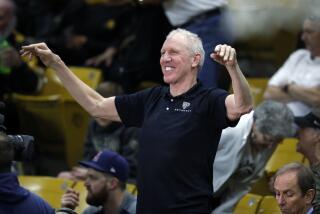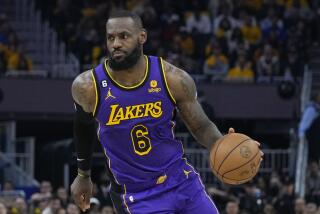Maravich Dies at 40 of Heart Attack : LSU Star Is Top Scorer in College Basketball History
- Share via
Pete Maravich, college basketball’s all-time scoring leader, died in Pasadena Tuesday morning, after collapsing during a pickup game at a church gym.
Maravich, 40, was pronounced dead at 9:23 a.m. at St. Luke’s Hospital in Pasadena, after hospital emergency room personnel had tried for 50 minutes to revive him. His death was attributed to a heart attack.
Maravich, in town to discuss plans for a movie about his life, was stricken during a half-court game in a gym at Pasadena’s First Church of the Nazarene, where he also was going to tape an interview for a religious radio show.
Gary Lydick, one of the players, said: “Maravich turned to walk away and immediately fell to the floor. He wasn’t playing hard at all, and then the next thing, he just fell.
“We could tell immediately that it was very severe. I’m sure he probably went into a seizure. His eyes started to roll and he became very jaundiced almost within a minute or two.”
Maravich’s sudden death shocked the basketball world.
“I’m extremely shocked--it threw me back,” said UCLA Coach Walt Hazzard, a National Basketball Assn. teammate of Maravich’s at Atlanta in the early 1970s. “He had unbelievable skills, a tremendously gifted athlete. I can’t believe it.
“Remember, they didn’t have the three-point line when Maravich played. I figure if he’d played with the three-point shot, you could add one-third more to his career scoring total.”
Calvin Murphy, a rival NBA guard who became a close friend, was all but speechless when informed of Maravich’s death early Tuesday.
“It’s too tough to talk now. I can’t talk about it,” he said, hanging up.
Jerry West, the Lakers’ general manager and a fellow NBA Hall of Fame guard, remembered Maravich, who played 10 years in the NBA until he retired in 1980, as bringing much-needed showmanship to the NBA.
“He was a really unique player who brought excitement and flair to the league at a time when the NBA really needed it,” West said. “It’s a real tragedy. He was such a religious guy . . . and he was very health conscious.”
John Wooden, former UCLA coach, used to room with Maravich’s father, Press, at a North Carolina boys’ basketball camp, where Wooden first saw Pete.
“Even then, as a little boy, he could do things with a basketball that were amazing,” he said. “I remember Press telling me: ‘I’m going to turn that boy into the first million-dollar pro basketball player.’
“Pete was a tremendous scorer, an outstanding shooter--but he never had an outstanding percentage because he took so many crazy shots. As an offensive player, I wouldn’t consider him as being in the class of Oscar Robertson or Jerry West, but he certainly was the best ballhandler I ever saw. “It’s so sad. He was so young.”
News of Maravich’s death shocked many at Louisiana State University in Baton Rouge, La., where Maravich scored 3,667 points, an all-time National Collegiate Athletic Assn. record, in his three seasons, ending in 1970. Maravich’s 44.5 and 44.2 one-season and career scoring averages are still NCAA records.
Press Maravich, Pete’s coach at LSU, died at 71 last April.
“I got a call from a Pasadena sportswriter this morning, who told me Pete had died suddenly,” said Jamie Kimbrough, LSU sports information director. “My first reaction was one of anger, because I thought it was a very bad joke. Pete was here just a month ago and seemed fine.
“Then when it registered with me that he was serious, the shock set in. Within 15 minutes, we were bombarded with calls from TV and radio stations, and newspapers.”
Maravich, known as Pistol Pete throughout his career, became embittered toward his alma mater after his father was fired by LSU in 1971. He severed relations with the school and only recently rejoined the LSU family.
Joe Dean, now LSU’s athletic director and a friend of Maravich in his college years, summed up LSU feelings Tuesday:
“To say we’re shocked would be the understatement of the year. We’re all deeply saddened. That young man had gone through so much, his mother’s suicide years ago, and Press’ death (last April).
“I can only say we’re happy he came back into the LSU family before he died. We unveiled a portrait of Pete and Press last month, and he came here for that.
“He has to be one of the greatest athletes to play any sport, anywhere in the world. I said when I introduced him here last month that, inch for inch and pound for pound, he was the greatest basketball player ever to step onto a court.”
Sportswriter Mike McKenzie of the Kansas City Star and Times, who knew Maravich well when he covered the Atlanta Hawks in the early 1970s, recalled Tuesday the depths of Maravich’s former bitterness toward LSU.
“In 1973, when he was with the Hawks, Atlanta was to play an exhibition game at the new LSU arena, the so-called House that Pete Built,” McKenzie recalled.
“I remember Pete saying to me before the game: ‘They’ve got my jersey hanging in a trophy case in there, and it has a hole in it--right in the back, where they stuck the knife into my father.’ ”
While widely acknowledged as one of basketball’s greatest offensive performers, the 6-foot 5-inch Maravich certainly never looked the part. He looked like a skinny, scruffy refugee from a YMCA league, with his trademark droopy socks flopping about his ankles, always a baggy, stretched-out jersey and a mop-style haircut.
But he had hands like Van Cliburn, a sprinter’s speed and ballhandling and passing skills that hadn’t been seen in the sport since the days of Goose Tatum, Bob Cousy and Meadowlark Lemon.
His game was a bewildering panorama of 25-foot feather-touch jump shots; behind-the-back, between-the-legs and around-the-neck bull’s-eye passes. One night, as an LSU sophomore, he scored 69 points against Alabama.
He had 28 50-point games at LSU. As a collegian, he scored more points than anyone else, more than Wilt Chamberlain, Oscar Robertson or Frank Selvy.
On the night he scored 69 against Alabama, he sank a half-court hook shot at the halftime buzzer.
In a 1969 interview with The Times, Maravich told of an unfulfilled dream, one that revealed the showman in the 22-year-old athlete.
“One thing I’ve always wanted to do is spin a ball on my finger, then, with one second left on the clock, bounce the ball off my head and into the basket, and win a game.”
Former USC coach Bob Boyd once pointed out that Maravich was a master at drawing fouls.
“All you had to do was just brush him when he was shooting, and he’d flop to the floor like a wet mackerel,” Boyd said.
Maravich made 893 free throws in three seasons, still the NCAA record.
He was born into the sport. For years, Maravich’s father told the story of a wager he made with the doctor on the June night in 1947 that Pete was born, in Aliquippa, Pa.
“I told the doctor at the hospital: ‘Doc, I want a son. If it’s a boy, I’ll pay you. If it’s a girl, you pay me.’
“The doctor agreed. Later, he emerged from the delivery room with a smile and said: ‘You pay.’ ”
If Maravich was steered into basketball by his father, though, he went willingly.
“I even took a basketball to bed with me until I was 14,” he said in his NBA Hall of Fame induction speech in 1986. “I would just lie there in bed, throwing it up and doing fingertip drills.”
His father. a former pro basketball player with the Pittsburgh Ironmen, maintained that hard work, not genes, turned his son into an outstanding player.
“When he was 7, I got him a basketball for Christmas, but he wasn’t interested--not until I shot a few baskets with it and made a few. It looked easy to him, and he took his first shot and missed. When I saw how angry he got at missing, I knew I had him hooked.”
Maravich was drafted by the NBA’s Atlanta Hawks in 1970 and immediately had problems with his teammates after signing a $1.9-million contract. During his pro career, Maravich also played with the New Orleans/Utah Jazz and the Boston Celtics.
An Atlanta teammate, John Vallely, remembered Maravich’s foot speed as much as his passing and shooting.
“His speed always impressed me as much as anything,” he said. “From one end of the court to the other, he was a step faster than anyone else in the league.
“As a pure shooter, he wasn’t a fundamentally good shooter, not in the way Jerry West was. Pete shot the ball differently every time he put it up. Sometimes he lobbed it up like a shotput. He was a great scorer, but not a great shooter.
“He was socially friendly with everyone on the team in Atlanta, but he was basically a loner. He hated the whole scene of dealing with the press, for example. He needed a lot of alone time. But when he was on the court, in front of a big crowd, he loved every bit of that. To Pete, that was showtime.”
In his New Orleans years, 1974-79, it was showtime in the Superdome, where Maravich sometimes attracted crowds of more than 30,000.
“I’m shocked,” said Butch van Breda Kolff, Maravich’s coach in New Orleans and now coach at Lafayette College in Easton, Pa. “It’s just so hard to believe.
“A lot of people remember the fancy passes, all those long jump shots. But I’ll always remember Pete’s great heart.
“One time I took him to a New Orleans health club and beat him in a racquetball game. He was furious. I mean, he wouldn’t speak to me. He got in his car and drove home at 75 m.p.h. The next day, he demanded another game, and beat me.
“One year the (team) gave our players an off-season conditioning program, and they told me it was so tough that probably no one would stick with it for the whole off-season. Pete did, and he was the only one.”
In the NBA, although Maravich was considered by some the game’s best ballhandler and scorer, some others called him a ball hog, hotdog, hothead and a loser.
“I play the way I’m told to play,” Maravich told The Times, in 1975. “I can play any kind of style anyone wants. Management wants me to shoot a lot and make a lot of good passes and they’re paying me, so that’s what I do.”
Maravich led the NBA in scoring one season, 1976-77. For his pro career, he averaged 24.2 points a game and played in five All-Star games.
He home was in Covington, La. He is survived by his wife, Jackie, and sons Jason, 8, and Joshua, 5.
MARAVICH IN COLLEGE
YR. SCHOOL G FG-FGA FT-FTA PTS. AVG. 1967-68 Louisiana State 26 432-1022 274-338 1138 43.8 1968-69 Louisiana State 26 433-976 282-378 1148 44.2 1969-70 Louisiana State 31 522-1168 337-436 1381 44.5 Totals 83 1387-3166 893-1152 3667 44.2
MARAVICH IN THE PROS
YR. TEAM G FG-FGA FT-FTA PTS. AVG. 1970-71 Atlanta 81 738-1613 404-505 1880 23.2 1971-72 Atlanta 66 460-1077 355-438 1275 19.3 1972-73 Atlanta 79 789-1788 485-606 2063 26.1 1973-74 Atlanta 76 819-1791 469-568 2107 27.7 1974-75 New Orleans 79 655-1562 390-481 1700 21.5 1975-76 New Orleans 62 604-1316 396-488 1604 25.9 1976-77 New Orleans 73 886-2047 501-600 2273 31.1 1977-78 New Orleans 50 556-1253 240-276 1352 27.0 1978-79 New Orleans 49 436-1035 233-277 1105 22.6 1979-80 Utah-Boston 43 244-543 91-105 589 13.7 Totals 658 6187-14025 3564-4344 15948 24.2
More to Read
Go beyond the scoreboard
Get the latest on L.A.'s teams in the daily Sports Report newsletter.
You may occasionally receive promotional content from the Los Angeles Times.










